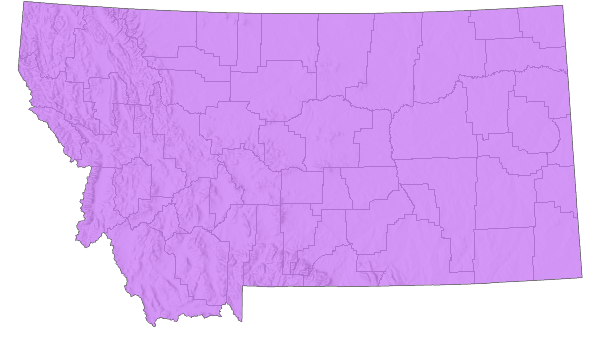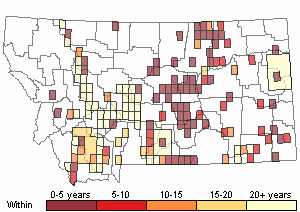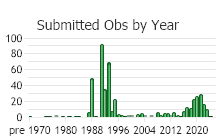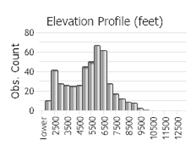View in other NatureServe Network Field Guides
NatureServe
Montana
Utah
Wyoming
Idaho
Wisconsin
British Columbia
South Carolina
Yukon
California
New York
White locoweed - Oxytropis sericea
Native Species
Global Rank:
G5
State Rank:
S4S5
C-value:
4
Agency Status
USFWS:
USFS:
BLM:
External Links
General Description
Acaulescent. Herbage appressed white-villous. Leaflets 11 to 21, lanceolate to narrowly ovate, 5–32 mm long. Stipules white-membranous, villous, adnate to the petiole, 8–22 mm long. Inflorescence of 5 to 20 flowers, 5–30 cm high including the peduncle. Flowers white to ochroleucous; calyx pilose with white and/or black hairs; sepals linear to lanceolate, 2–4 mm long; banner 16–25 mm long. Legumes erect, sessile, 15–25 mm long, black- and/or white-strigose, thick and rigid, the walls 0.5–1 mm thick (
Lesica et al. 2012. Manual of Montana Vascular Plants. BRIT Press. Fort Worth, TX).
Our plants are varieties
sericea and
speciosa (Torr. & A. Gray) S.L. Welsh.
Species Range
Montana Range
Range Descriptions

 Native
Native
Range Comments
YT south to NV, NM and TX (Lesica et al. 2012. Manual of Montana Vascular Plants. BRIT Press. Fort Worth, TX).
Observations in Montana Natural Heritage Program Database
Number of Observations: 624
(Click on the following maps and charts to see full sized version)
Map Help and Descriptions
Relative Density

Recency



 (Observations spanning multiple months or years are excluded from time charts)
(Observations spanning multiple months or years are excluded from time charts)
Habitat
Ecology
POLLINATORS The following animal species have been reported as pollinators of this plant species or its genus where their geographic ranges overlap:
Bombus appositus,
Bombus bifarius,
Bombus centralis,
Bombus fervidus,
Bombus flavifrons,
Bombus melanopygus,
Bombus nevadensis,
Bombus rufocinctus,
Bombus sylvicola,
Bombus occidentalis,
Bombus insularis, and
Bombus kirbiellus (Macior 1974, Bauer 1983, Shaw and Taylor 1986, Williams et al. 2014, Miller-Struttmann and Galen 2014).
Stewardship Responsibility
References
- Literature Cited AboveLegend:
 View Online Publication
View Online Publication Bauer, P.J. 1983. Bumblebee pollination relationships on the Beartooth Plateau tundra of Southern Montana. American Journal of Botany. 70(1): 134-144.
Bauer, P.J. 1983. Bumblebee pollination relationships on the Beartooth Plateau tundra of Southern Montana. American Journal of Botany. 70(1): 134-144. Lesica, P., M.T. Lavin, and P.F. Stickney. 2012. Manual of Montana Vascular Plants. Fort Worth, TX: BRIT Press. viii + 771 p.
Lesica, P., M.T. Lavin, and P.F. Stickney. 2012. Manual of Montana Vascular Plants. Fort Worth, TX: BRIT Press. viii + 771 p. Macior, L.M. 1974. Pollination ecology of the Front Range of the Colorado Rocky Mountains. Melanderia 15: 1-59.
Macior, L.M. 1974. Pollination ecology of the Front Range of the Colorado Rocky Mountains. Melanderia 15: 1-59. Miller-Struttmann, N.E. and C. Galen. 2014. High-altitude multi-taskers: bumble bee food plant use broadens along an altitudinal productivity gradient. Oecologia 176:1033-1045.
Miller-Struttmann, N.E. and C. Galen. 2014. High-altitude multi-taskers: bumble bee food plant use broadens along an altitudinal productivity gradient. Oecologia 176:1033-1045. Shaw, D.C. and R.J. Taylor.1986. Pollination ecology of an alpine fell-field community in the North Cascades. Northwest Science 60:21-31.
Shaw, D.C. and R.J. Taylor.1986. Pollination ecology of an alpine fell-field community in the North Cascades. Northwest Science 60:21-31. Williams, P., R. Thorp, L. Richardson, and S. Colla. 2014. Bumble Bees of North America. Princeton, NJ: Princeton University Press. 208 p.
Williams, P., R. Thorp, L. Richardson, and S. Colla. 2014. Bumble Bees of North America. Princeton, NJ: Princeton University Press. 208 p.
- Additional ReferencesLegend:
 View Online Publication
View Online Publication
Do you know of a citation we're missing? Harvey, S.J. 1990. Responses of steppe plants to gradients of water soil texture and disturbance in Montana, U.S.A. Ph.D. Thesis. Bozeman, MT: Montana State University. 34 p.
Harvey, S.J. 1990. Responses of steppe plants to gradients of water soil texture and disturbance in Montana, U.S.A. Ph.D. Thesis. Bozeman, MT: Montana State University. 34 p. Johnson, T. W. 1982. An analysis of pack and saddle stock grazing areas in the Bob Marshall Wilderness. M.Sc.Thesis. Bozeman, MT: Montana State University. 105 p.
Johnson, T. W. 1982. An analysis of pack and saddle stock grazing areas in the Bob Marshall Wilderness. M.Sc.Thesis. Bozeman, MT: Montana State University. 105 p. King, L.A. 1980. Effects of topsoiling and other reclamation practices on nonseeded species establishment on surface mined land at Colstrip, Montana. M.Sc. Thesis. Bozeman, MT: Montana State University. 129 p.
King, L.A. 1980. Effects of topsoiling and other reclamation practices on nonseeded species establishment on surface mined land at Colstrip, Montana. M.Sc. Thesis. Bozeman, MT: Montana State University. 129 p. Lesica, P., M.T. Lavin, and P.F. Stickney. 2022. Manual of Montana Vascular Plants, Second Edition. Fort Worth, TX: BRIT Press. viii + 779 p.
Lesica, P., M.T. Lavin, and P.F. Stickney. 2022. Manual of Montana Vascular Plants, Second Edition. Fort Worth, TX: BRIT Press. viii + 779 p. Martin, S.A. 1985. Ecology of the Rock Creek bighorn sheep herd, Beartooth Mountains, Montana. M.Sc. Thesis. Bozeman, MT: Montana State University. 152 p.
Martin, S.A. 1985. Ecology of the Rock Creek bighorn sheep herd, Beartooth Mountains, Montana. M.Sc. Thesis. Bozeman, MT: Montana State University. 152 p. Meier, G.A. 1997. The colonization of Montana roadsides by native and exotic plants. M.Sc. Thesis. Bozeman, MT: Montana State University. 45 p.
Meier, G.A. 1997. The colonization of Montana roadsides by native and exotic plants. M.Sc. Thesis. Bozeman, MT: Montana State University. 45 p. Quire, R.L. 2013. The sagebrush steppe of Montana and southeastern Idaho shows evidence of high native plant diversity, stability, and resistance to the detrimental effects of nonnative plant species. M.Sc. Thesis. Bozeman, MT: Montana State University. 124 p.
Quire, R.L. 2013. The sagebrush steppe of Montana and southeastern Idaho shows evidence of high native plant diversity, stability, and resistance to the detrimental effects of nonnative plant species. M.Sc. Thesis. Bozeman, MT: Montana State University. 124 p. Saunders, J.K. Jr. 1955. Food habits and range use of the Rocky Mountain goat in the Crazy Mountains, Montana. Journal of Wildlife Management 19(4):429-437.
Saunders, J.K. Jr. 1955. Food habits and range use of the Rocky Mountain goat in the Crazy Mountains, Montana. Journal of Wildlife Management 19(4):429-437. Saunders, J.K., Jr. 1954. A two-year investigation of the food habits and range use of the Rocky Mountain goat in the Crazy Mountains, Montana. M.Sc. Thesis. Bozeman, MT: Montana State University. 22 p.
Saunders, J.K., Jr. 1954. A two-year investigation of the food habits and range use of the Rocky Mountain goat in the Crazy Mountains, Montana. M.Sc. Thesis. Bozeman, MT: Montana State University. 22 p. Seipel, T.F. 2006. Plant species diversity in the sagebrush steppe of Montana. M.Sc. Thesis. Bozeman, MT: Montana State University. 87 p.
Seipel, T.F. 2006. Plant species diversity in the sagebrush steppe of Montana. M.Sc. Thesis. Bozeman, MT: Montana State University. 87 p. Williams, K.L. 2012. Classification of the grasslands, shrublands, woodlands, forests and alpine vegetation associations of the Custer National Forest portion of the Beartooth Mountains in southcentral Montana. M.Sc. Thesis. Bozeman, MT: Montana State University. 376 p.
Williams, K.L. 2012. Classification of the grasslands, shrublands, woodlands, forests and alpine vegetation associations of the Custer National Forest portion of the Beartooth Mountains in southcentral Montana. M.Sc. Thesis. Bozeman, MT: Montana State University. 376 p.
- Web Search Engines for Articles on "White locoweed"





